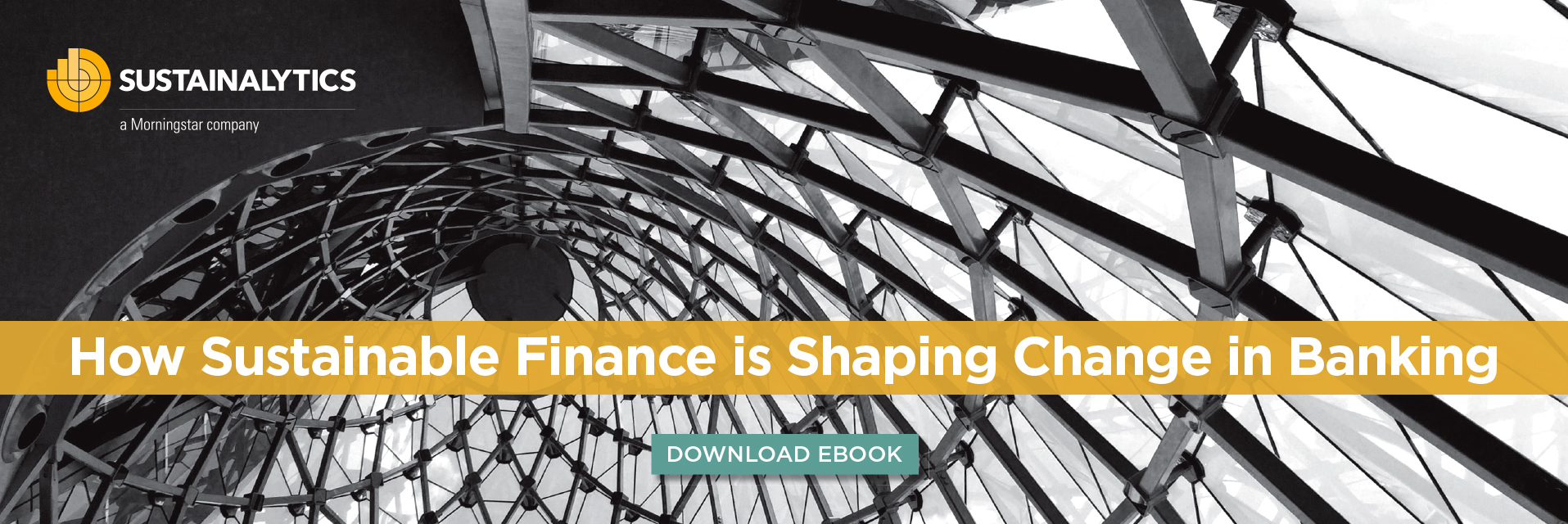Leading banks are increasingly considering environmental, social, and governance (ESG) risks. The reasons range from market demands and stakeholder expectations, to expanding awareness of ESG issues and the regulations designed to address them. There are also financial and non-financial benefits to prioritizing sustainability. For example, given their central role in financing, banks are uniquely positioned to benefit from the exponential growth in the sustainable finance market, estimated to exceed $50 trillion in the next five years.
But banks can only take advantage of this market if they have built a strong reputation based on credible commitments to sustainable banking. In this blog post, we'll cover these and other key reasons banks are embracing sustainable finance.
Reason One: Market Demand for Sustainable Banking Products
As private sector actors seek to improve their sustainability performance, they need financing for ESG-focused projects. Banks have responded by offering new financial instruments, including products that provide access to borrowers in industries not traditionally considered green.
Sustainability-linked debt, for instance, can apply to any sector. This range of products grew more than 300% from 2017 to 2020.i Companies ranging from AccorHotels to Sydney Airport have entered into sustainability-linked loans.
Reason Two: International Calls for Action
Various international agreements have prompted banks and institutional investors to finance projects that tackle pressing social and environmental issues. Some of the most important commitments are the Paris Climate Agreement, the European Union’s Green Deal, and the United Nations’ 2030 Agenda with its 17 Sustainable Development Goals (SDGs).
The UN’s Principles for Responsible Banking, for example, require banks to align their strategies and practices with the SDGs and the Paris Agreement. To date, over 40% of the global banking sector has signed on to the principles.ii
Reason Three: A Supportive Regulatory Environment for Sustainable Banking
Countries around the globe have introduced frameworks to direct capital to sustainable economic activities.
Europe, Middle East, Africa
The EU Taxonomy for Sustainable Activities sets the economic activities that qualify as sustainable. The Russian Central Bank has made recommendations for sustainable investment principles and emission standards for the use of funds from green and social bonds.iii
Americas
The United States’ proposed ESG Disclosure Simplification Act of 2021 would require publicly traded companies to disclose ESG information in their Securities and Exchange Commission filings. This measure would also provide banks with important additional data on potential borrowers.
Asia-Pacific
Recent legislation in China, Singapore, Japan, and Hong Kong is supporting sustainable finance.iv For example, China’s Green Credit Guidelines put in place a reporting system for green credit.
Reason Four: Decreased Exposure to Sustainability-Related Risks
ESG-related issues such as rising sea levels, inflated senior management compensation, or human rights violations in a product’s supply chain, can carry major risks to banks’ finances and reputations. In the EU alone, climate change may put up to 15% of banks’ balance sheets at risk.v
Sustainable banking products can help mitigate a bank’s exposure to ESG-related risks and improve profitability. Green financing policies in China, for example, were found to have a positive impact on banks’ non-performing loan ratios.vi
Reason Five: Enhanced Reputation
More and more, stakeholders are comparing banks based on their sustainability pledges. By putting in place an effective ESG strategy and targets, banks can show their commitment to sustainability, promote their credibility, and reduce the risks of greenwashing. In comparison, banks with weak sustainable finance frameworks and targets may face public criticism.
For example, it’s not hard to imagine a whistleblower making plausible-sounding allegations that a bank has misrepresented its ESG investments. Whether the allegations are true or not, the bank might be investigated by financial market regulators, get potentially damaging media attention, and see its market value decline.
Why Banks are Embracing Sustainable Banking – A Convergence of Opportunities
Sustainable banking is growing rapidly. A decade ago, ESG was a niche; now the sustainable finance market is worth over $30 trillion.
Addressing climate change alone may require more than $1 trillion per year over the next 20 years. Others suggest the number might reach $3.5 trillion per year to transition to a green economy. And that is not considering financing for other ESG issues.
The pressure to address environmental, social, and governance problems is increasing from governments, citizens, business, and international agreements. Companies want to transition to sustainability, and they need financing to do it. At the same time, steady updates to standards and regulations are making sustainable finance more consistent, credible, and easy to manage. Banks that are prepared to take meaningful action early will have an advantage over their peers as the sustainable finance market matures.
In short, sustainability is here to stay, sustainable finance is booming, and banks are in the perfect position to profit while also doing good.
To learn more about how banks are implementing sustainable finance strategy, click here or the banner below to read our ebook, How Sustainable Finance is Shaping Change in Banking.

Sources
i Bullard, N. (2021), “The Sustainable Debt Market is All Grown up,” Bloomberg, accessed (11.09.2021) at: https://www.bloomberg.com/news/articles/2021-01-14/the-sustainable-debt-market-is-all-grown-up
ii UN Environmental Programme Finance Initiative (2021), “Principles for Responsible Banking Signatories,” UN Principles for Responsible Banking, accessed (04.10.2021) at: https://www.unepfi.org/banking/bankingprinciples/prbsignatories/
iii Central Bank of Russia (2020), “On recommendations for implementing the principles of responsible investment No. IN-06-28/111,” Central Bank of Russia, accessed (18.08.2021) at: https://www.cbr.ru/Content/Document/File/112325/IN-06-28_111_e.PDF
iv OECD (2020), “Developing Sustainable Finance Definitions and Taxonomies,” OECD, accessed (18.08.2021) at: https://www.oecd.org/env/developing-sustainable-finance-definitions-and-taxonomies-134a2dbe-en.htm
v Eceiza, J., Harreis, H., Härtl, D., Viscardi, S. (2020), “Banking Imperatives for managing climate risk,” McKinsey & Co, accessed (29.09.2021) at: https://www.mckinsey.com/business-functions/risk-and-resilience/our-insights/banking-imperatives-for-managing-climate-risk
vi Cui, Y. (2018), “The Impact of Green Lending on Credit Risk in China,” Sustainability, accessed (17.08.2021) at: https://doi.org/10.3390/su10062008
Recent Content
Risk and Opportunity in Biodiversity: How Sustainable Finance Can Help
This article outlines how biodiversity loss poses material risks to business and how it connects to many other issues that companies can’t ignore. In addition, it covers how biodiversity conservation presents substantial economic opportunities, and how businesses can address and access these opportunities by issuing linked instruments that integrate biodiversity considerations.
Today’s Sustainable Bond Market: Boosting Confidence in Sustainable Bond Issuances
In this article, we examine the kinds of sustainable bonds offered in the market, some of the key regulations being developed in different markets and the current initiatives to improve the quality and credibility of issuances.
Webinar Recap: How Integrating ESG Can Drive Opportunity for Private Companies
Recently, Morningstar Sustainalytics hosted a webinar – ESG in the Lifecycle of a Private Company: How Stakeholder Demands Drive Sustainability in Private Markets – to address some of the questions private companies might have surrounding ESG and how it could impact their business.






